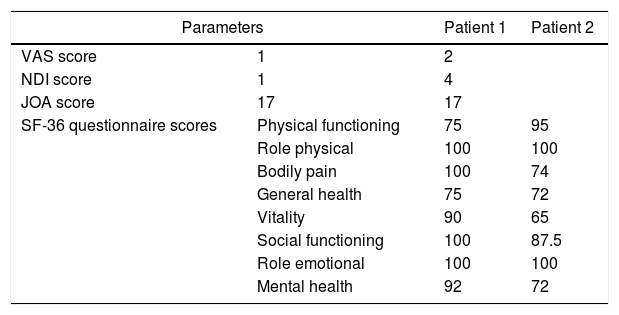We present two cases of minimally invasive posterior transarticular screw fixation of C1-C2. The points for screw insertion were visualized by endoscopy via the instrumental port. A patient with a type III odontoid fracture with subluxation underwent a minimally invasive posterior stand-alone transarticular screw fixation. Despite the application of compression screws, for technical reasons, only minimal compression on the anterior third of the C1-C2 lateral joint was achieved. However, complete fracture fusion was achieved with stable fibrous C1-C2 fusion 2.5 years postoperatively. A second patient with a chronic type II odontoid fracture underwent percutaneous C1-C2 fixation by the same method. After 2 years, fracture fusion and C1-C2 lateral mass ankylosis were achieved. The use of a tubular retractor and endoscopy in stand-alone screw fixation of C1-C2 allows direct visualization of the screw entry point and decreases surgical trauma. This procedure might be an alternative to other methods of transarticular instrumentation.
Presentamos dos casos de fijación posterior artroscópica con tornillo transarticular en C1-C2. Las ubicaciones para la inserción del tornillo se visualizaron mediante un trocar para el endoscopio. Un paciente con una fractura de apófisis odontoides de tipo III con luxación parcial se sometió a fijación posterior artroscópica con tornillo independiente transarticular. A pesar de la aplicación de tornillos de compresión y, por motivos técnicos, solo se logró una compresión mínima del tercio anterior de la articulación lateral C1-C2. Sin embargo, se logró la artrodesis completa de la fractura, con una artrodesis en C1-C2 fibrosa estable después de dos años y medio de la intervención quirúrgica. Un segundo paciente con una fractura de apófisis odontoides de tipo II crónica se sometió a fijación percutánea en C1-C2 con el mismo método. Después de dos años, se logró la artrodesis de la fractura y de la masa lateral en C1-C2. El uso de un separador tubular y de la endoscopia en la fijación con tornillo independiente en C1-C2 permite la visualización directa del punto de entrada del tornillo y disminuye el traumatismo quirúrgico. Este procedimiento puede ser una alternativa a otros métodos de exploración instrumental transarticular.
Article

If it is the first time you have accessed you can obtain your credentials by contacting Elsevier Spain in suscripciones@elsevier.com or by calling our Customer Service at902 88 87 40 if you are calling from Spain or at +34 932 418 800 (from 9 to 18h., GMT + 1) if you are calling outside of Spain.
If you already have your login data, please click here .
If you have forgotten your password you can you can recover it by clicking here and selecting the option ¿I have forgotten my password¿.










